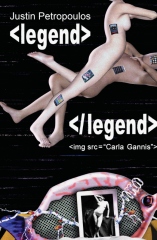legend legend (Jaded Ibis, 2013) by Justin Petropoulos and Carla Gannis
Review by Philip Metres
A mutual friend once joked that Justin
Petropoulos would one day write a memoir in which he never appeared. That’s precisely the aesthetic that guides
his poetry and the vision that it encompasses; reading Petropoulos is like
reading the rebellious child of language poetry and dystopian fiction—it’s
militantly forbidding at first glance, but intriguingly quotable once one
settles into its chaotic disjunctive music.
His second book, legend legend, (Jaded Ibis, 2013)—a collaboration with artist Carla Gannis—emerges from a
series of redactions of Edna Kenton’s The
Book of Earths, a 1928 compendium of various global written and visual
imagings of our planet. It has since morphed
into a series of art engagements (digital and performance-based, including digital
paintings, animations, projection mapped & 3D printed sculptures) which
have extended the project beyond the space-time constraints of the book. (Check
out their web presence if you’d like to co-create, for example, by redaction
techniques.)
From the very opening lines, we have the
sense of bodies navigating cities, bodies against themselves, against others:
“they walk their feet against/ours speak with likelihood/are your heels higher
than /your head we admire hanging/orchards the philosophers’/cities suppose a
citizenry/digging with a spoon” (15).
The corresponding image suggests the contortions that such urban
geographies impose upon the body. The
final line, “digging with a spoon,” evokes the absurd situation of these subject-bodies. It’s suggestive of fruitless labor, and also
echoes the classic prisoner’s attempt to escape from a life sentence.
The entire work is pressurized by this
sense of the oppressive architectures of late capitalist life. But the vision of this book is not
suffocatingly dystopic—or rather, it is dystopic in the way that dystopias tend
to be beset with fissures, sites of release, apocalypse. “When the world becomes bad,” it states at
one point, “make it over again” (23). The
book—itself a recycling of books—is interested in making a new world from the
remnants of the old. The wreckage of old
maps and myths, if plumbed and recombined, could produce the space for the
new.
Petropoulos’ language, embracing the
antinarrativity of much language poetry, has that constitutive element of
drawing into focus or clarity and then departing again, the way radio stations
come in and out of signal as one passes by cities—if one were in a supersonic
jet. The danger for the reviewer is not
to suggest overly obvious meanings of individual lines merely explain themselves,
when the wholeness of the text embraces a kind of chaos beyond any simplistic
utterances of single phrases. “Meaning,”
the text warns, “is what/we wither into” (114).
That said, I’d like to isolate some of my
favorite phrases, which feel like keys to the engine of this work: “if water
stretching endlessly bounded”
(25); “buried city an uncovering/of
clauses we know historicity”
(30); “into each sketch of sleep
policies/are financed” (32); “it’s possible to sketch largely with no/
detail how a dictionary smells”(35); “so
many mirages/he could not reconcile” (49); “the urge to glue things/together/ things which hatch/escaping”
(56). We see the poet’s attempt goes
beyond simply to “shore ruins” (as Eliot’s speaker in “The Waste Land”); he
feels the way in which language itself is also implicated in the ruination.
The book is not illustrated exactly, but
re-imaged by Gannis, the way Petropoulos redacts The Book of Earths. Her
drawings are replete with bodies penetrating and penetrated by themselves, as
if imprisoned by the bodies’ tentacular longings and imprisonments, the
machinery of desire that gives birth to cities and digital virtualities and
endless mirrors. But amid the
postapocalyptic visions, both textual and visual, something else is possible, nascent,
growing.
The longing for the body through (and
beyond) the language is where the text constantly pulls. The gorgeous section, “[spooky action at a
distance]” feels like an erotic creation story in its own right, riven by
blanks and pauses, as if to show us that connection is what is still aimed for,
despite the disjuncture:
sometimes she is powered
with stars
sometimes along her spine his ever
after beneath her sinking passed into
the mouth again at dawn would take us
too far this is story in the
beginning that stirless rest together
(38-39).
In those pauses is a positing of the
possible.
